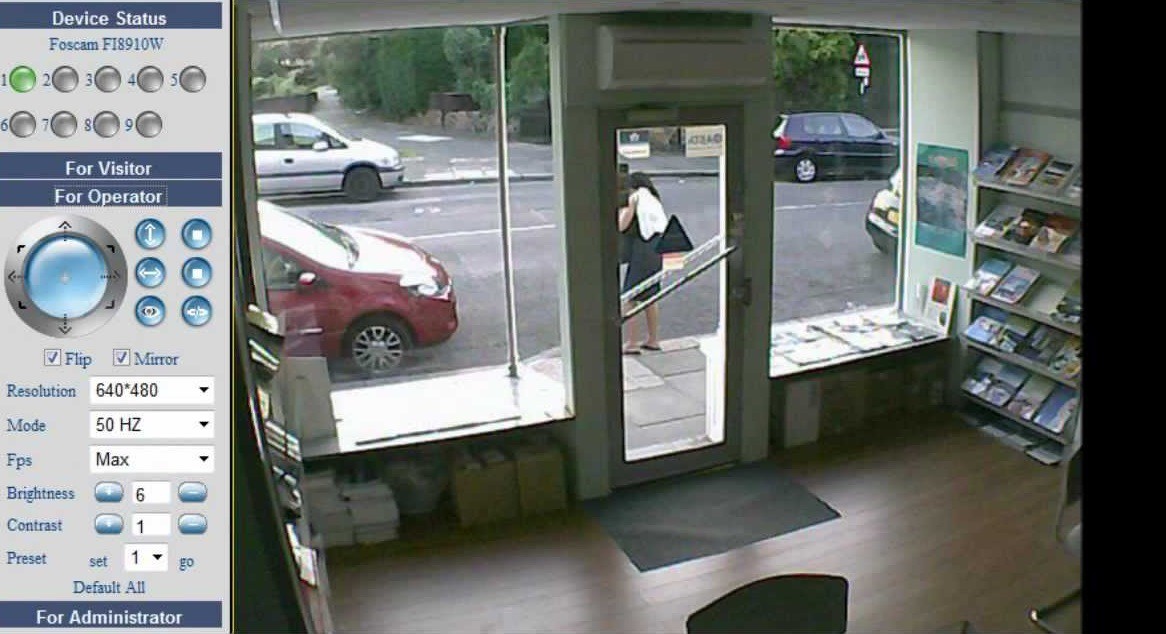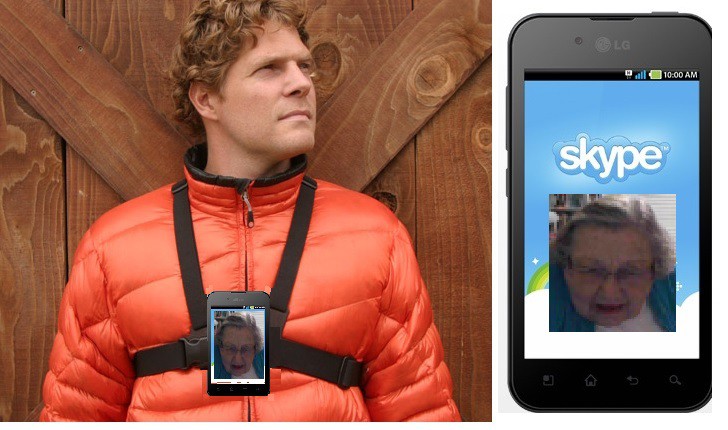Results of a recent study concerning computer technology and people with disabilities indicate that virtual reality tours are effective in conveying information and, in some cases, reducing anxiety. Disabled persons (DP) or disadvantaged people (DP) sometimes can't get out to tour museums, sporting events, family picnics, walks in the park, a business meeting, church, visit neighbors, etc.
WARNING: This can NOT be used at movie theaters and cinemas due to copyright rules and regulations. Venue owners may eject you from building if you use this there. The venue will ostensibly reject any written formal petition to do this for DP's too. So don't waste your time with copyright-protected venues and stick with public domains where they are more sensitive to DP's (ADA) needs..

This idea allows the DP to schedule a person (Man-Cam Unit or MCU) to take their camera rig to any event of the DP's choosing (within reason). Others can view the live stream but can not control the camera. The DP purchases all tickets and refreshments for the Man-Cam operator ahead of time (or send you the cash via PayPal). The DP can see and hear everything around the MCU. Keep it at that or it can not be viewed as not-for-profit. They would only be covering your expenses like maybe gasoline/petrol too.
If the DP can not view something on their own with the software's joystick, they can ask the MCU to move to a better position for better viewing. They do this via a private text chat room and not the built-in 2-way audio link. Even though the MCU az-el cam does have 2-way audio, some museums, libraries, and other venues would view this as disruptive (unless headphones were used). Also the MCU would be confused by the talking coming from the loudspeaker, especially if the DP has speech disabilities. Hence the MCU instructions would come from a private chat room text (typed by DP or their nurse). Others could also post in this chat room - but the chief DP would have precedence over other posters.
 The DP would have a Smartphone with cardboard VR goggles at their bed or wheelchair. The streaming multimedia would be fed to the VR goggles. Or if the VR goggles are problematic for remote control, it could just be a tablet, smartphone, PC, or laptop. The GUI (graphical user interface) has remote controls (R/C) on the screen that is either touch-screen, mouse, or keyboard manipulated (or via MindFlex or head-tracker software like CAMERA MOUSE 2015).
The DP would have a Smartphone with cardboard VR goggles at their bed or wheelchair. The streaming multimedia would be fed to the VR goggles. Or if the VR goggles are problematic for remote control, it could just be a tablet, smartphone, PC, or laptop. The GUI (graphical user interface) has remote controls (R/C) on the screen that is either touch-screen, mouse, or keyboard manipulated (or via MindFlex or head-tracker software like CAMERA MOUSE 2015).
 The MCU is mounted on utility cart from the A/V Dept at school or a GoPro chest harness. The MCU pushes an easily-searched unconcealed plastic A/V (audio/visual) wheeled utility cart with the laptop that streams the web-cam through a tethered (use PDANET software) 3G/4G Smartphone and is accessible via the cellphone's IP address (or use the venue's wi-fi hot spot (access point or AP)). The power for the camera comes from a 12 volt rechargeable gell-cell or lead-acid car battery on the bottom shelf of the utility cart. The cart is might more acceptable by the venue as they can watch you remove it from your car/truck, wheel it inside (empty), and set it up and test it in front of their security people. The laptop and cellphone can recharge off of the gell-cell or car battery. You can recharge the battery in a wall outlet at the venue (or at home) for a couple of hours before the event. You could use a 12vdc-110vac power inverter and OEM (original equipment manufactures) power packs.
The MCU is mounted on utility cart from the A/V Dept at school or a GoPro chest harness. The MCU pushes an easily-searched unconcealed plastic A/V (audio/visual) wheeled utility cart with the laptop that streams the web-cam through a tethered (use PDANET software) 3G/4G Smartphone and is accessible via the cellphone's IP address (or use the venue's wi-fi hot spot (access point or AP)). The power for the camera comes from a 12 volt rechargeable gell-cell or lead-acid car battery on the bottom shelf of the utility cart. The cart is might more acceptable by the venue as they can watch you remove it from your car/truck, wheel it inside (empty), and set it up and test it in front of their security people. The laptop and cellphone can recharge off of the gell-cell or car battery. You can recharge the battery in a wall outlet at the venue (or at home) for a couple of hours before the event. You could use a 12vdc-110vac power inverter and OEM (original equipment manufactures) power packs.
OPTIONAL CHEST MOUNTED VERSION (QUICK & DIRTY METHOD - costly too)
The image above is a iPHONE or Android phone mounted on a GoPro harness and has NO connecting power or Ethernet cables at all. It depends on it's own battery, 3G/4G connection, or venue's WI-Fi AP, and a Skype connection with group videoconferencing. The MCU wears a Bluetooth headset or wired ear plug set to receive commands from end-user (i.e. they can't see the screen for text chatting as it's on their chest). Skype can allow multiple videoconferencing users connected too. This is not the main theme we are working with here. MCU can use a pocket mirror to see end-user instead of taking it off the Go-Pro harness
THIS PICTURE ABOVE SHOULD HAVE CAMERA MOUNTED ON A UTILITY CART
SEE UTILITY CART VERSION NEAR BOTTOM OF THIS TEXT
If the MCU needs a rest room break they can call in a quick AFK (away from keyboard used by gamers) to the DP and the video and sound goes temporarily dark (mute microphone and put black handkerchief over phone camera instead of dropping the connection. However, MCU food and refreshment breaks should be televised for the DP's enjoyment. Due to battery limitations a set amount of hours must be adhered to. Also most museums worldwide close at 5PM too, So start early in the morning, recharge rig at lunchtime, and see the event before closing time. You may need to rush the DP a little and not linger too long on any one exhibit. Also you will need service elevators for your cart on multi-floor events.
All MCU financials like car fuel, tickets, and refreshments can be handled by the DP's nursing representative via PayPal, etc. All arrangements with venues to allow this video and other issues need to be handled by the MCU beforehand to avoid any issues with venue security personnel who will undoubtedly stop them and question them. A letter from venue management allowing such a thing could be carried around during the tour to stop unwanted interference from security and museum employees. Also borrowing the DP's handicap parking pass will help in parking and loading/unloading. You would be doing this for the handicap person DIRECTLY, so it should be legal. Check with your venue's management on that, not police, as it is a private parking area not public. Never park on street as bad guys may break your windows to get at your equipment or the car. Most venues have private lots or garages where ADA arrangements are made for DP's. And the venue's security guards may help you unload too. Get a letter of permission from DP to use their Handicap Pass to help them perform this action in their name. Let the police officer see this project too on your SmartPhone to prove your case.
BTW - the web-cam requires 5 volts not 12 volts. The same applies to the Smartphone. So some sort of 12-5 volt converter needed. Like a 12vdc - 110vac power inverter and a outlet block for the 3-4 power packs.
Also a utility push cart may prove to be better than any carry-in luggage or back pack. Here is somebody who's already doing it - skip to time-stamp 6:10 for human-totted version:
Teleprescense robots at museums are OK but they are slow and clumsy. What if the museum built their own version (or you help them) of this and stored it in their security office. And you volunteer to man it from time to time? This would eliminate any operational security issues and they might pay for it. They'd just need some one to push it around.
Here's my utility cart version:

The disabled person can activate the 2-way audio feature of the web-cam and the MCU person can carry a paper photo of the disabled person to show people interested in the operation. Also the end-user can make the web-cam nod yes or shake no.
WARNING!!! Make sure you go to the venue a day or so before to check out where all your 3G/4G dead spots are or see if you can use the venue's Wi-Fi AP from all locations at the venue. You also need a fallback notification system or method to know when you are NOT transmitting multimedia or if power is failing. Bring a external hard-drive to capture all multimedia off-line so you have a back-up plan. The DP will be very disappointed if the system captured NOTHING and you were totally unaware of it until later in the day! You need to view a live feed while you are walking around the venue too. Also find out if it's OK to borrow the handicap parking pass from the DP as you are doing this FOR him/her and it only seems fair since you have all this heavy equipment to lug into the venue from your car. Technically you are bringing the handicap person with you virtually. (Some police officer may not agree with this logic) . Just a thought...
A large external hard drive to capture the multimedia session offline as well as online. Use the security camera software setting to record motion or something.
WARNING: watch your equipment like a hawk!!! Tie-wrap and bungee cord all equipment on the cart. Don't have any wires or objects sticking out. Use bicycle lock on your cart and cover your stuff with a black drape or have a partner watch your stuff when you go into restroom or AFK. Be prepared to sign HHA (hold harmless agreements) and have a COI (certificate of insurance - liability) for the venue management. DP should pay for it (temporary event liability insurance policy) or you can get a inexpensive personal liabilty policy to cover you away from your home. You'll regret not having one the first time an elderly lady claims she tripped and fell because of your equipment or it's wires & cables. Also watch out for sharp edges sticking out. That's another liability concern. Push everything in on the cart's shelves.
EOT
(End of text - for now)
 chris jones
chris jones